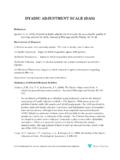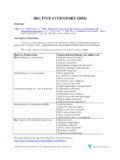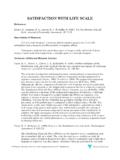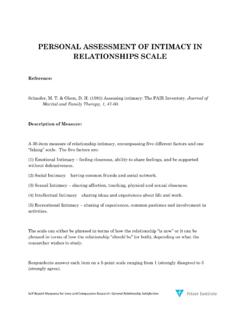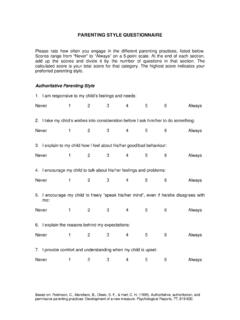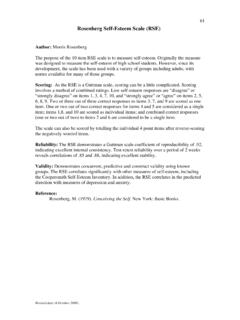Transcription of ORIGINAL ATTACHMENT THREE-CATEGORY MEASURE
1 Self Report Measures for Love and Compassion Research: ATTACHMENT ORIGINAL ATTACHMENT THREE-CATEGORY MEASURE Reference: Hazan, C., & Shaver, P. R. (1987). Romantic love conceptualized as an ATTACHMENT process. Journal of Personality and Social Psychology, 52, 511-524. Description of MEASURE : This is the first MEASURE of adult ATTACHMENT . It is a 3-item questionnaire designed to MEASURE one s ATTACHMENT style. The three ATTACHMENT styles are (paraphrased from Hazan & Shaver, 1987): Avoidant- Characterized as being afraid of intimacy, experiencing emotional highs and lows during relationships, along with much jealousy. Anxious/Ambivalent- View love in an obsessive way, with strong need for constant reciprocation and validation, along with emotional highs and lows, and feelings of jealousy and strong sexual attraction. Secure- Describe their romantic relationships as friendly, trusting, and happy.
2 They accept their partners regardless of faults. The tend to have long and fulfilling relationships. For more information on adult ATTACHMENT , visit this website: Abstracts of Selected Related Articles: Bartholomew, K., & Shaver, P. R. (1998). Methods of assessing adult ATTACHMENT : Do they converge? In J. A. Simpson & W. S. Rholes (Eds.), ATTACHMENT theory and close relationships (pp. 25 45). New York: Guilford Press. In recent years, several streams of research have emerged from Bowlby's (1988) and Ainsworth's (1982) ATTACHMENT theory. Originally, the theory was aimed at explaining child and adult psychopathology in terms of nonoptimal relationships between children and their caregivers, or " ATTACHMENT figures." According to ATTACHMENT theory, the long-term effects of early experiences with caregivers are due to the persistence of "internal working models" --cognitive / affective schemas, or representations, of the self in relation to close relationship partners (Bartholomew, 1990; Shaver, Collins, & Clark, 1996).
3 Theoretically, these representations influence a person's expectations, emotions, defenses, and relational behavior in all close relationships. Although the theory does not assume or require that internal working models persist without ,::hange across the life span, both theory and empirical evidence from longitudinal studies have led researchers to suspect that the effects of childhood ATTACHMENT relationships extend into adulthood, where they can be seen in the domains of parenting and close peer relationships, including romantic relationships ( , Bartholomew, 1990, 1993; Main, Kaplan, & Cassidy, 1985; Shaver, Hazan, & Bradshaw, 1988; Weiss, 1982). Self Report Measures for Love and Compassion Research: ATTACHMENT Crowell, J., & Treboux, D. (1995). A review of adult ATTACHMENT measures: Implications for theory and research. Social Development, 4, 294-327.
4 There has been increasing interest in adult ATTACHMENT from both theoretical and empirical perspectives. Because the test of a theory is based on our ability to assess theoretical constructs, the review is organized around assessment techniques. Delineating the content, focus, assumptions, and correlates of different ATTACHMENT measures highlights central issues and problems in conducting research in adult ATTACHMENT . In this review, we present theoretical issues related to adult ATTACHMENT , in particular, individual differences, working models, and the role of ATTACHMENT in adult life. A summary of the measures commonly used in the study of adult ATTACHMENT follows. The literature review is organized by MEASURE , examining topics such as relations between childhood experiences and adult ATTACHMENT status, and adult ATTACHMENT and adult personality and functioning, parenting and partnership behavior.
5 Studies which explore relations between measures are discussed before concluding with thoughts about future directions. Feeney, J. A. (1994). ATTACHMENT style, communication patterns and satisfaction across the life cycle of marriage. Personal Relationships, 1, 333-348. questionnaire measures of ATTACHMENT , communication patterns, and relationship satisfaction were administered to 361 married couples, sampled across the life cycle of marriage. Individuals who were secure in ATTACHMENT (defined in terms of comfort with closeness and low anxiety over relationships) tended to be paired with secure spouses. Security of ATTACHMENT was associated with one's own relationship satisfaction, although husbands' satisfaction was related primarily to the anxiety dimension. The most consistent effect of partners' ATTACHMENT was an inverse relationship between wives' anxiety and husbands' satisfaction.
6 The negative effect of wives' anxiety on perceived relationship satisfaction (for both partners) was evident primarily for couples in which husbands were uncomfortable with closeness. The association between ATTACHMENT dimensions and relationship satisfaction was largely mediated by communication patterns for wives, but only partially mediated by communication patterns for husbands; for both husbands and wives, a MEASURE of mutually constructive communication emerged as the strongest correlate of satisfaction. These findings were generally consistent across the life cycle of marriage, and they are important in clarifying the nature of the link between ATTACHMENT and satisfaction in a broad sample. Self Report Measures for Love and Compassion Research: ATTACHMENT Scale: These questions are concerned with your experiences in romantic love relationships.
7 Take a moment to think about these experiences and answer the following questions with them in mind. Read each of the three self-descriptions below (A, B, and C) and then place a checkmark next to the single alternative that best describes how you feel in romantic relationships or is nearest to the way you feel. (Note: The terms "close" and "intimate" refer to psychological or emotional closeness, not necessarily to sexual intimacy.) _____A. I am somewhat uncomfortable being close to others; I find it difficult to trust them completely, difficult to allow myself to depend on them. I am nervous when anyone gets too close, and often, others want me to be more intimate than I feel comfortable being. _____B. I find it relatively easy to get close to others and am comfortable depending on them and having them depend on me. I don't worry about being abandoned or about someone getting too close to me.
8 _____C. I find that others are reluctant to get as close as I would like. I often worry that my partner doesn't really love me or won't want to stay with me. I want to get very close to my partner, and this sometimes scares people away. Self Report Measures for Love and Compassion Research: ATTACHMENT THE RELATIONSHIPS questionnaire (RQ) Reference: Bartholomew, K. & Horowitz, L. M. (1991). ATTACHMENT styles among young adults: A test of a four- category model. Journal of Personality and Social Psychology, 61, 226-244. Description of MEASURE : This is a 4-item questionnaire designed to MEASURE adult ATTACHMENT style. The RQ extends the ORIGINAL ATTACHMENT THREE-CATEGORY MEASURE (Hazan & Shaver, 1987) by rewording the descriptions of each of the ATTACHMENT styles , and by adding a fourth style dismissing-avoidant. Dismissing-avoidant people are characterized as avoiding intimacy, being highly self-reliant and independent.
9 (Bartholomew & Horowitz, 1991). For more information on adult ATTACHMENT , visit this website: Abstracts of Selected Related Articles: Scharfe, E., & Bartholomew, K. (1994). Reliability and stability of adult ATTACHMENT patterns. Personal Relationships,1, 23-43. A basic premise of ATTACHMENT theory is that internal models of ATTACHMENT remain relatively stable across the life span. We examined stability and change in adult ATTACHMENT representations over 8 months in a sample of young adults (N = 144; Mean age = years). ATTACHMENT patterns were assessed by categorical and continuous ratings across three methods self-report ratings, expert ratings based on semi-structured interviews, and reports of romantic partners and showed moderate stability. Interview ratings tended to show higher stability than self-report ratings. Changes in ATTACHMENT ratings (across methods) were not consistently related to life events that had occurred in the intervening 8 months.
10 The relationship between reliability and stability was discussed, and where the "true" stability could be estimated independent of unreliability, it was found to be very high (r's ranging from .72 to .96). The results highlight the importance of using multiple indicators in assessing adult ATTACHMENT and using continuous rather than categorical ratings in the assessment of stability. Fraley, R. C., & Shaver, P. R. (2000). Adult romantic ATTACHMENT : Theoretical developments, emerging controversies, and unanswered questions. Review of General Psychology. The authors review the theory of romantic, or pair-bond, ATTACHMENT as it was originally formulated by C. Hazan and P. R. Shaver in 1987 and describe how it has evolved over more than a decade. In addition, they discuss 5 issues related to the theory that need further clarification: (a) the nature of ATTACHMENT relationships, (b) the evolution and function of ATTACHMENT in adulthood, (c) models of individual differences in ATTACHMENT , (d) continuity and change in ATTACHMENT security, and (e) the integration of ATTACHMENT , sex, and caregiving.


